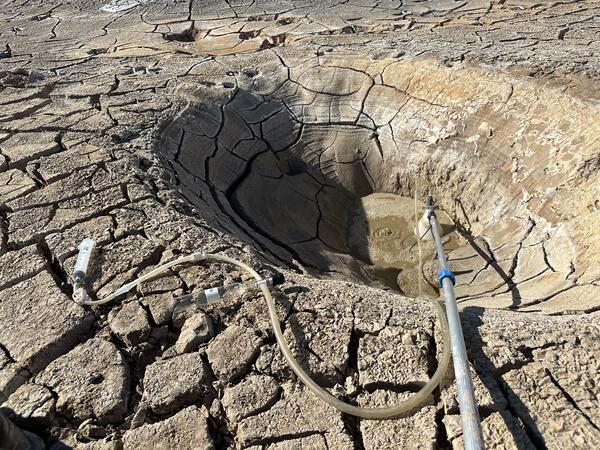The Salton Buttes volcanic field is the youngest and southernmost of the fields associated with the North American and Pacific plate boundary. Five obsidian rhyolite domes erupted on the southern shore of the Salton Sea between 6000 and 500 years ago. The area is active geothermally and seismically, with numerous hot springs and mudpots on the surface.
Multimedia
Images
The Salton Buttes volcanic field is the youngest and southernmost of the fields associated with the North American and Pacific plate boundary. Five obsidian rhyolite domes erupted on the southern shore of the Salton Sea between 6000 and 500 years ago. The area is active geothermally and seismically, with numerous hot springs and mudpots on the surface.

Volcanic gas sampling at a mud pool, Salton Buttes, California
Volcanic gas sampling at a mud pool, Salton Buttes, CaliforniaTo sample volcanic gases, inverted funnels connected to an evacuated sample bottle by tubing are sealed over a fumarole. Painter's poles are used to reach gas vents across dangerous (hot, unstable, or fragile) ground.
Volcanic gas sampling at a mud pool, Salton Buttes, California
Volcanic gas sampling at a mud pool, Salton Buttes, CaliforniaTo sample volcanic gases, inverted funnels connected to an evacuated sample bottle by tubing are sealed over a fumarole. Painter's poles are used to reach gas vents across dangerous (hot, unstable, or fragile) ground.
A mud pot releases a burst of gas in the Davis-Schrimpf Seep Field near the Salton Sea. The geothermal area here is related to the same faulting and volcanic system which created the Salton Buttes lava domes. USGS photo by Deb Bergfeld, 2016.
A mud pot releases a burst of gas in the Davis-Schrimpf Seep Field near the Salton Sea. The geothermal area here is related to the same faulting and volcanic system which created the Salton Buttes lava domes. USGS photo by Deb Bergfeld, 2016.

Mudpots near Salton Buttes on the edge of the Salton Sea
Mudpots near Salton Buttes on the edge of the Salton SeaMudpots bubble and steam near the Salton Buttes lava domes, a volcanic area at the southeastern end of the Salton Sea, California.
Mudpots near Salton Buttes on the edge of the Salton Sea
Mudpots near Salton Buttes on the edge of the Salton SeaMudpots bubble and steam near the Salton Buttes lava domes, a volcanic area at the southeastern end of the Salton Sea, California.



